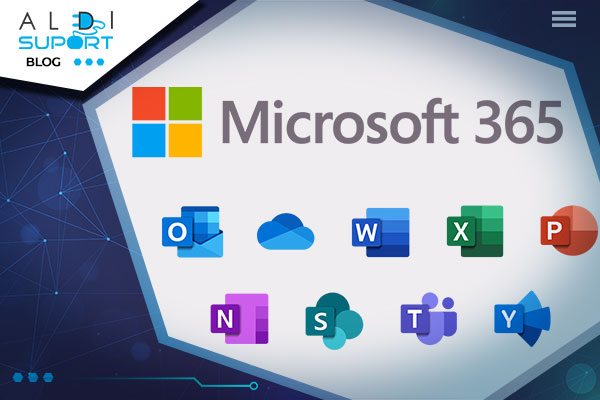In today’s digital age, data security and efficient collaboration are essential for the success of any organization. With remote work becoming the norm, protecting sensitive information and maintaining smooth collaboration among team members have become major priorities. Microsoft 365 offers a wide range of tools that can help organizations secure their data and improve work efficiency. In this article, we will explore how to use these tools to protect your data and collaborate more effectively.
Authentication and Access Control
Two-Factor Authentication (2FA)
The first step to protecting your data is to ensure that only authorized persons have access to it. Two-factor authentication (2FA) is an effective method of adding an extra layer of security. With 2FA, users must provide two forms of identification—typically a password and a code generated on a mobile device.
Tips for Implementing 2FA:
- Enable 2FA for Sensitive Accounts: Make sure that all accounts with access to sensitive data are protected with 2FA.
- Use Authentication Apps: Recommend users to use authentication apps like Microsoft Authenticator to generate verification codes.
- User Education: Educate your team on the importance of 2FA and how to use it correctly.
Identity and Access Management (IAM)
Role-Based Access Control
To prevent unauthorized access to sensitive information, it is essential to implement an identity and access management (IAM) system. Role-based access control (RBAC) allows you to grant specific permissions to users based on their roles in the organization.
Tips for Using IAM:
- Clearly Define Roles: Create clear and well-defined roles within the organization, with specific permissions assigned to each role.
- Regularly Review Permissions: Conduct periodic reviews of permissions to ensure that users have access only to the information they need.
- Use Microsoft Azure AD: Use Microsoft Azure Active Directory to manage user identities and access in a centralized and secure manner.
Data Encryption
Protecting Data in Transit and at Rest
Data encryption is essential for protecting sensitive information both in transit and at rest. Microsoft 365 offers several encryption options to ensure that your data is protected at all times.
Tips for Using Encryption:
- Encrypting Emails: Use Microsoft Outlook to encrypt emails and prevent unauthorized access to information transmitted via email.
- Encrypting Files: Ensure that all files stored in OneDrive and SharePoint are encrypted to prevent unauthorized access.
- Encrypting Data in Transit: Use encryption protocols such as TLS (Transport Layer Security) to protect data in transit between devices and servers.
Threat Monitoring and Response
Threat Detection and Prevention
Microsoft 365 includes advanced tools for threat monitoring and response, helping organizations detect and prevent cyberattacks. These tools use artificial intelligence and machine learning to identify suspicious activities and respond quickly to incidents.
Tips for Threat Monitoring and Response:
- Enable Microsoft Defender: Use Microsoft Defender to protect devices and data against malware and other cyber threats.
- Monitor Suspicious Activities: Set up alerts to be immediately notified of suspicious or unusual activities in your accounts and devices.
- Quick Incident Response: Establish an incident response plan and ensure that your team is prepared to react quickly in the event of a cyberattack.
Data Backup and Recovery
Ensuring Data Continuity
An effective data backup and recovery plan is essential for protecting against data loss due to cyberattacks, hardware failures, or human errors. Microsoft 365 offers robust data backup and recovery solutions to ensure the continuity of your operations.
Tips for Data Backup and Recovery:
- Implement Regular Backups: Ensure that all important data is regularly backed up using Microsoft 365 solutions.
- Test Recovery Procedures: Conduct periodic tests of data recovery procedures to ensure that you can quickly and efficiently restore information in the event of data loss.
- Store Backups in Secure Locations: Store backups in secure and redundant locations to prevent data loss due to hardware failures or cyberattacks.
User Education and Awareness
Creating a Security Culture
One of the most important steps to protecting data is educating users about best security practices. Creating a security culture in your organization can help prevent human errors and reduce the risk of cyberattacks.
Tips for User Education and Awareness:
- Periodic Security Training: Organize periodic training sessions to inform users about the latest cyber threats and best security practices.
- Phishing Attack Simulations: Conduct phishing attack simulations to test user vigilance and identify weak points.
- Promote Open Communication: Encourage users to report any suspicious activity or security incidents without fear of repercussions.
Using Microsoft Teams for Secure Collaboration
Collaborating Safely
Microsoft Teams is an essential tool for remote collaboration, offering advanced security features to protect communications and data. With Teams, you can collaborate safely with colleagues and external partners, ensuring that sensitive information remains protected.
Tips for Using Microsoft Teams Securely:
- Set Access Permissions: Control access to channels and files by setting specific permissions for users and groups.
- Encrypt Communications: Ensure that all chat and video communications are encrypted to prevent unauthorized access.
- Monitor Activities in Teams: Use Teams’ monitoring and reporting features to identify suspicious activities and respond quickly to incidents.
Integrating Microsoft 365 with Other Security Solutions
Enhancing Security
Integrating Microsoft 365 with other security solutions can enhance data and device protection. For example, you can integrate Microsoft 365 with endpoint security solutions to ensure comprehensive protection against cyber threats.
Tips for Integrating Microsoft 365:
- Use Endpoint Security Solutions: Integrate Microsoft 365 with endpoint security solutions to protect user devices against malware and other threats.
- Sync with Incident Management Tools: Use incident management tools to sync data and alerts from Microsoft 365 with other security platforms.
- Implement Cloud Security Solutions: Integrate Microsoft 365 with cloud security solutions to protect data stored and processed in the cloud.
Mobile Device Management (MDM)
Protecting Mobile Devices
With more employees working from mobile devices, it is essential to implement a mobile device management (MDM) system to protect data and ensure compliance with the organization’s security policies.
Tips for Using MDM:
- Implement Mobile Security Policies: Configure security policies for mobile devices, including data encryption, authentication, and application management.
- Monitor and Manage Devices: Use MDM solutions to monitor and manage employee mobile devices, ensuring that they comply with security policies.
- Configure Mobile Device Backups: Ensure that data on mobile devices is regularly backed up to prevent information loss.
Evaluating and Improving Security
Periodic Security Assessments
To ensure that your security measures are effective, it is important to conduct periodic security assessments and implement improvements where necessary. Microsoft 365 offers tools and resources to help you evaluate and improve security.
Tips for Evaluating and Improving Security:
- Security Audits: Conduct security audits to identify vulnerabilities and implement remediation measures.
- Security Testing: Perform penetration tests and attack simulations to evaluate the effectiveness of your security measures.
- Updating Security Policies: Regularly review and update security policies to ensure they reflect the latest threats and best practices.
Conclusion
Effectively using Microsoft 365 tools to protect data and enhance collaboration can completely transform how your organization operates. From two-factor authentication and data encryption to mobile device management and integrating with other security solutions, these measures provide comprehensive protection against cyber threats. Start implementing these strategies and see how your work becomes safer and more efficient.
Întrebări Frecvente
How can I implement two-factor authentication (2FA) for my Microsoft 365 accounts?
Enable 2FA from account settings and recommend users to use authentication apps like Microsoft Authenticator.
What are the best practices for encrypting data in Microsoft 365?
Encrypt emails, files stored in OneDrive and SharePoint, and use encryption protocols for data in transit.
How can I use Microsoft Teams for secure collaboration?
Set access permissions, ensure communications are encrypted, and monitor activities in Teams to identify suspicious activities.
What tools does Microsoft 365 offer for threat monitoring and response?
Use Microsoft Defender for protection against malware and set up alerts for suspicious activities.
How can I protect my employees’ mobile devices?
Implement mobile security policies, monitor devices with MDM solutions, and ensure data is regularly backed up.
How can I evaluate and improve my data security?
Conduct security audits, perform penetration tests, and regularly update security policies to reflect the latest threats and best practices.





